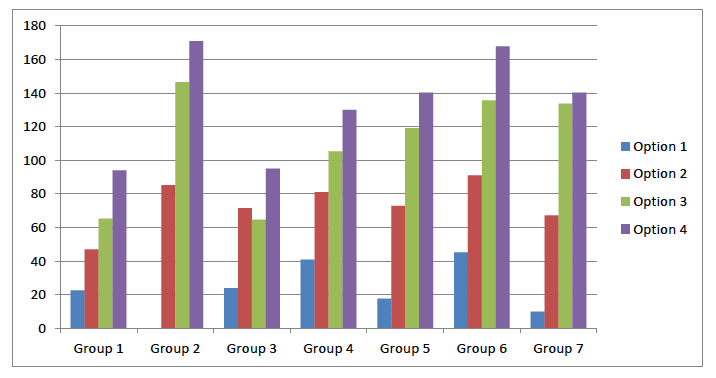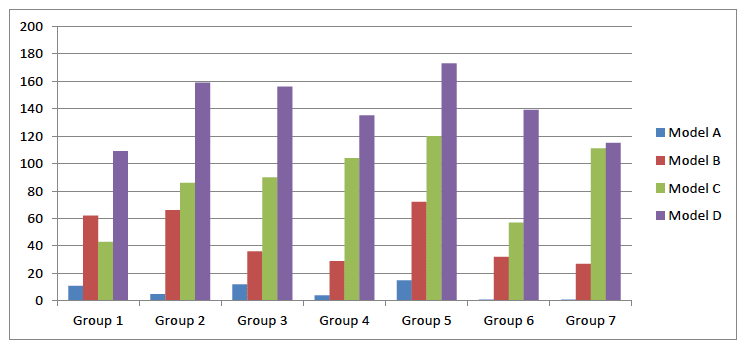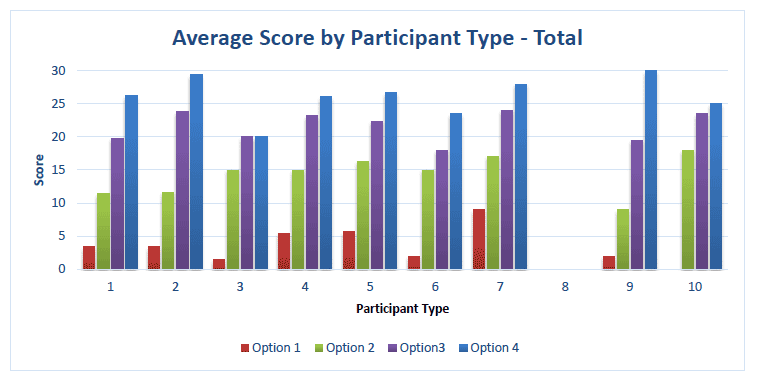Honouring the lived experience: Rape and Sexual Assault Victims Taskforce option appraisal report
A report summarising the approach, methodology, findings and recommendations of the options appraisal exercise carried out in June 2018 as part of the Chief Medical Officer's Taskforce to Improve Services for Victims of Rape and Sexual Assault.
8. Scoring Analysis
8.1 Participant Coding
Participant coding is as follows for both morning and afternoon sessions.
| Makeup of scorers | am | pm |
|---|---|---|
| Number of "1 - Service User (survivor) | 5 | 5 |
| Number of "2 - Police Scotland | 5 | 5 |
| Number of "3 - Social Work (government and non-governmental) | 2 | 2 |
| Number of "4 - NHS Staff (clinicians) | 17 | 17 |
| Number of "5 - NHS Staff (non-clinicians) | 15 | 15 |
| Number of "6 - Voluntary Organisations | 2 | 2 |
| Number of "7 - NHS Scotland National Board | 1 | 1 |
| Number of "8 - COPFS (Non-scorer AM) | 0 | 1 |
| Number of "9 - Scottish Government | 2 | 2 |
| Number of "10 - Local Authority | 2 | 2 |
| Total | 51 | 52 |
8.2 Number of scorers for each session
There were a total of 51 scorers in the morning and 52 in the afternoon session. There may be minimal discrepancies in representative analyses as two separate scoring sheets were used. One participant left and anther joined for the afternoon session. Some participants brought previous versions from emailed information and did not use the final versions in the pack provided on the day. There was no impact on the overall scoring for the sessions.
8.3 Scoring - Service Options
Table 4 - Unweighted Scores for all Options by Groups
| Score: | Group 1 | Group 2 | Group 3 | Group 4 | Group 5 | Group 6 | Group 7 | Totals: | % | Ranking |
|---|---|---|---|---|---|---|---|---|---|---|
| Option 1 | 34 | 0 | 38 | 55 | 22 | 65 | 18 | 232 | 7% | 4 |
| Option 2 | 68 | 122 | 99 | 109 | 115 | 133 | 99 | 745 | 21% | 3 |
| Option 3 | 98 | 217 | 95 | 153 | 171 | 203 | 196 | 1133 | 33% | 2 |
| Option 4 | 135 | 243 | 132 | 187 | 204 | 240 | 205 | 1346 | 39% | 1 |
| Totals | 335 | 582 | 364 | 504 | 512 | 641 | 518 | 3456 | 100% |
Table 5- Weighted Scores All Options, all Groups
| Score: | Group 1 | Group 2 | Group 3 | Group 4 | Group 5 | Group 6 | Group 7 | Totals: | % | Ranking |
|---|---|---|---|---|---|---|---|---|---|---|
| Option 1 | 22.5 | 0 | 23.8 | 40.8 | 17.6 | 45.1 | 9.9 | 159.7 | 7% | 4 |
| Option 2 | 46.9 | 85.2 | 71.5 | 81.1 | 72.9 | 91 | 67.2 | 515.8 | 21% | 3 |
| Option 3 | 65.2 | 146.6 | 64.7 | 105.2 | 119.1 | 135.7 | 133.7 | 770.2 | 33% | 2 |
| Option 4 | 94 | 170.9 | 95 | 130 | 140.3 | 167.9 | 140.3 | 938.4 | 39% | 1 |
| Totals | 228.6 | 402.7 | 255 | 357.1 | 349.9 | 439.7 | 351.1 | 2384.1 | 100% |
Graph 1: The histogram graph above reflects the data in table 5 above.

The function of including the Status Quo 'do nothing' model is to provide a benchmark so that the value of the alternative 'do something' models may be judged by reference to current service provision.
All groups scored Option 4 as the highest scoring. 72% of the scoring was applied to options 3 and 4. Although each of the groups scored the status quo low, Group 2 reached a group decision to score the status quo as a zero which reflected the guidance given by the option appraisal lead that a zero score had been included to reflect the view that the current service adds no value going forward.
Table 6 - All groups summary by Quality Dimension - Service Delivery Options
| Option 1 | Total | Weighting | Weighted total | Rank | |
|---|---|---|---|---|---|
| 1 | Person-centredness | 41 | 2.0 | 82 | |
| 2 | Effective | 36 | 0.8 | 29 | |
| 3 | Safe | 39 | 0.6 | 23 | |
| 4 | Equitable | 33 | 0.4 | 13 | |
| 5 | Timely | 41 | 0.2 | 8 | |
| 6 | Efficient | 41 | 0.1 | 4 | |
| Total for Option 1 = | 160 | 4 | |||
| Option 2 | |||||
| 1 | Person-centredness | 126 | 2.0 | 252 | |
| 2 | Effective | 124 | 0.8 | 99 | |
| 3 | Safe | 139 | 0.6 | 83 | |
| 4 | Equitable | 114 | 0.4 | 46 | |
| 5 | Timely | 114 | 0.2 | 23 | |
| 6 | Efficient | 128 | 0.1 | 13 | |
| Total for Option 2 = | 516 | 3 | |||
| Option 3 | |||||
| 1 | Person-centredness | 185 | 2.0 | 370 | |
| 2 | Effective | 191 | 0.8 | 153 | |
| 3 | Safe | 199 | 0.6 | 119 | |
| 4 | Equitable | 180 | 0.4 | 72 | |
| 5 | Timely | 182 | 0.2 | 36 | |
| 6 | Efficient | 196 | 0.1 | 20 | |
| Total for Option 3 = | 770 | 2 | |||
| Option 4 | |||||
| 1 | Person-centredness | 232 | 2.0 | 464 | |
| 2 | Effective | 233 | 0.8 | 186 | |
| 3 | Safe | 233 | 0.6 | 140 | |
| 4 | Equitable | 206 | 0.4 | 82 | |
| 5 | Timely | 216 | 0.2 | 43 | |
| 6 | Efficient | 226 | 0.1 | 23 | |
| Total for Option 4 = | 938 | 1 | |||
Table 6 above covers all groups across the 6 quality dimensions. Before weighting options 2, 3 and 4 have scored Safe highest with option 1 showing equal scores for person-centredness, equitable and efficient. When the scores are weighted all participant scores show person centred to be the most important. In both weighted and unweighted scoring the ranking of the options remains the same with the same percentage proportions across all groups.
8.4 Service Option Scoring Outcome
As a result of the morning scores the option deemed viable and deliverable in accordance with service options criterion is described below
Option 4 Multi-Agency Centre for adults, children and young people who have experienced rape and sexual assault (acute and historic).
8.5. Scoring Analysis - Service Configuration
Table 7 - Score for all Groups - Service Configuration
| Model A | Model B | Model C | Model D | |
|---|---|---|---|---|
| Group 1 | 11 | 62 | 43 | 109 |
| Group 2 | 5 | 66 | 86 | 159 |
| Group 3 | 12 | 36 | 90 | 156 |
| Group 4 | 4 | 29 | 104 | 135 |
| Group 5 | 15 | 72 | 120 | 173 |
| Group 6 | 1 | 32 | 57 | 139 |
| Group 7 | 1 | 27 | 111 | 115 |
| Total | 49 | 324 | 611 | 986 |
| % | 3% | 16% | 31% | 50% |
Table 7 above is a record of the scores across all groups in relation to the Essential, important and desirable factors to design and deliver a person centred, safe, effective service configuration for people who experience sexual assault & rape in Scotland.
The total scores illustrate that overall all 7 groups voted Model D as the preferred model for implementation. The percentage of the vote split by option shows Model D represented 50% of the participants' votes.
The graph represents all group scores across all models.
Graph 2 - The histogram below represents the distribution of all participant votes across all models.

8.6 Service Configuration Model Outcome
Model D was voted the highest service configuration model across all groups with the narrowest margin recorded between option 3 and 4 in group 7.
Model D - Local services which meet the HIS standards, delivered as close as possible to the point of need and supported by a centre of excellence.
Model D was subject to detailed discussion and by consensus with all participants it was agreed that this needed to be amended to describe a service configuration with locally delivered services at the heart, supported by a centre of excellence.
The participants felt strongly that the model should not just describe a 'centre' (i.e. the physical building) but should capture the key elements of the service to be provided (which may be delivered out with that physical space).
The centre (s) of excellence (CoE) would be a dedicated specialist team, a shared facility or an entity that provides the following: - resources, guidance, leadership, best practices, co-ordination of services, research, support and/or education, training and development. This would be provided for staff working to support people locally who have been sexually assaulted or raped. A CoE could provide core services, when necessary outreach to local areas when required. The centre and services would support appropriately trained qualified staff to undertake a forensic medical examination. As a multidisciplinary team approach is central to the model, a holistic and seamless service could be provided to meet the needs of people and address a range of demands from clinical requirements to support and recovery in a coordinated manner.
This model is based on delivering the vision of how services could be best designed to deliver high quality care, treatment and support for recovery for survivors. This multi-agency option would provide clarity regarding a route/s for self-referral, enable services to be accessed locally; consolidate relationships with a crisis/advocacy support worker; and co-ordinate ongoing support and recovery services.
In early work within the taskforce (May, 2017) it was agreed that a clear point of access into services should be national, staffed over 24 hours and enable people to get to the right place, with support from a multi-agency team in a location as close as possible to them as quickly as possible.
This service configuration model requires a lot more work to agree the detail; however the model enables better equity of access to the right person in the right place first time. This could be through a centre or services for all in Scotland and with the access to a 24 hour number.
At this stage it is not known how many of the specialist centres/services there will be in Scotland. However it needs to be understood that the principle is that services will firstly be accessed locally in a facility equipped to provide the highest quality of service to meet the agreed standards.
The Taskforce will consider the most appropriate way to reflect this in the final name of the agreed model. Participants also felt that whilst this was the preferred model for adults and young people, that the existing service provision for children (under 12) was working well (although there was a clear commitment to improvement and in particular trauma & recovery services). There was an appetite to look at how future developments in relation to how the Barnahus concept could build on this, taking cognisance of social work policy, responsibilities and guidelines in relation to child protection as well as those of other partner agencies.
The event noted the Barnahus concept in England for response to child sexual abuse had worked well and posed the question as to whether a similar model would also work in Scotland.
8.6 Further Analyses
In order to test the robustness of the results of the option appraisal an assessment of the sensitivity of the ranking of the scores to key variables and assumptions was carried out.
Graph 3 - below recorded the outcome of the morning scoring exercise for each individual group (by group), by combination and what the outcome/ranking would have been.

Table 7 below represents an average score across all factors and participant score for the afternoon session.
| Model A | Model B | Model C | Model D | |
|---|---|---|---|---|
| Number of "1 - Service User (survivor) | 0 | 0 | 5 | 18 |
| Number of "2 - Police Scotland | 0 | 4 | 11 | 22 |
| Number of "3 - Social Work (government and non-governmental) | 0 | 9 | 10 | 22 |
| Number of "4 - NHS Staff (clinicians) | 1 | 8 | 15 | 21 |
| Number of "5 - NHS Staff (non-clinicians) | 2 | 11 | 12 | 20 |
| Number of "6 - Voluntary Organisations | nil | nil | nil | nil |
| Number of "7 - NHS Scotland National Board | 0 | 2 | 15 | 19 |
| Number of "8 - COPFS (Non-scorer AM) | 0 | 0 | 18 | 4 |
| Number of "9 - Scottish Government | 0 | 1 | 7 | 19 |
| Number of "10 - Local Authority | nil | nil | nil | nil |
Graph 4 above represents the votes for all models across all participants coding. For the purpose of clarity the coding of participants may differ from am and pm sessions due to accuracy of the template used. Some participants used the previous emailed version which was re-coded for the final version in the packs on the day. This did not compromise the outcome as shown in the analysis.
Contact
There is a problem
Thanks for your feedback